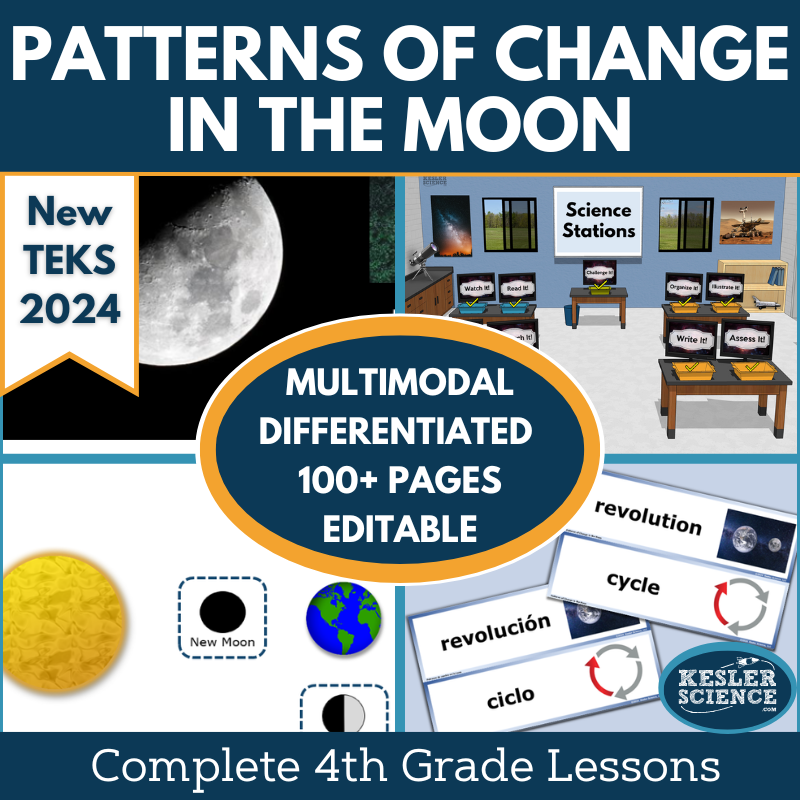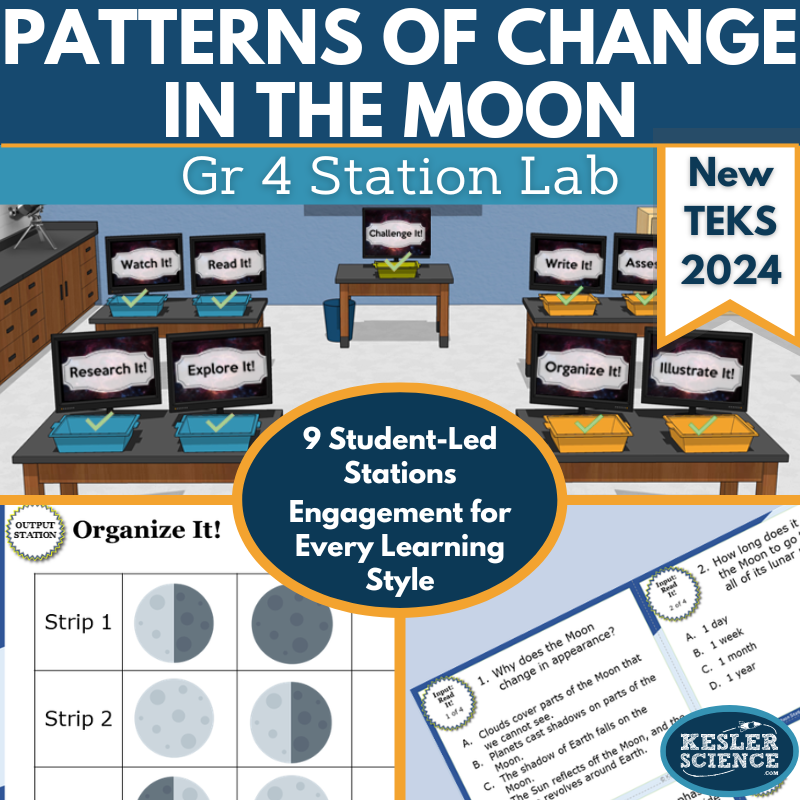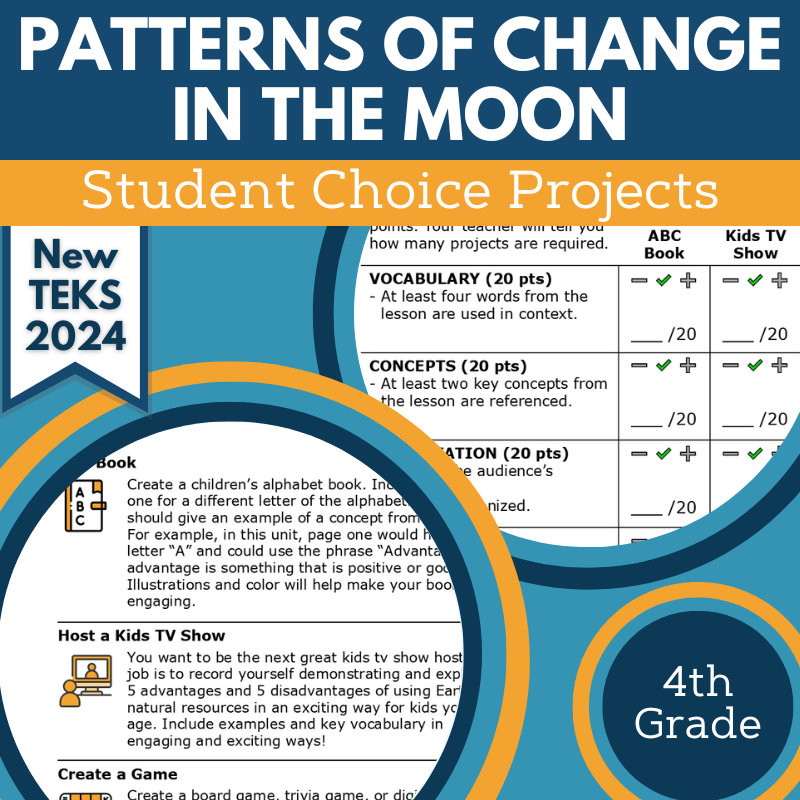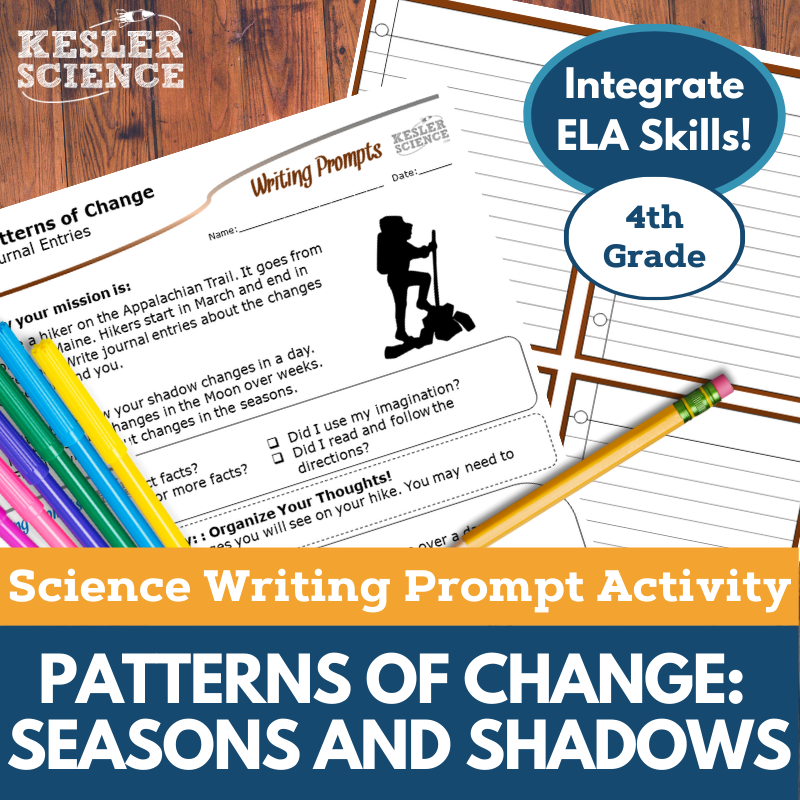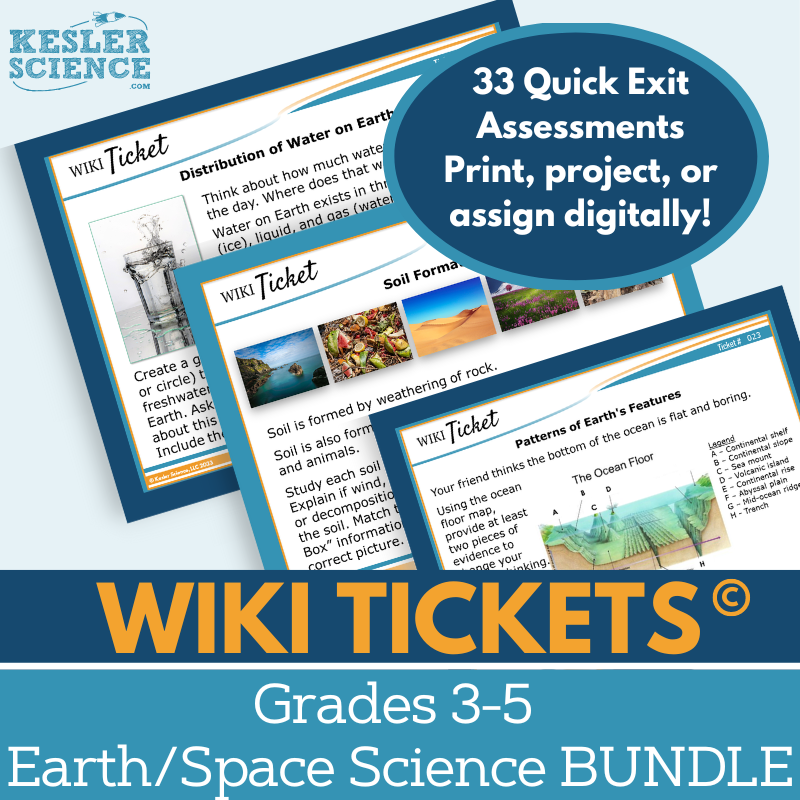Patterns of Change in the Moon Activities for 4th Grade Science
This 4th-grade 5E space science lesson, aligned with TEKS 4.9B, guides students in collecting and analyzing data to predict patterns in the Moon’s changing appearance. The resources below will give students a comprehensive understanding of patterns in the Moon's appearance. All of the following materials are also included in the Kesler Science Membership.
The Kesler Science 5E Lesson is an engaging space science unit for 4th grade, focused on collecting and analyzing data to identify sequences and predict patterns of change in the Moon’s appearance from Earth. It features editable presentations, worksheets, choice projects, and assessments designed for differentiated, student-led learning with minimal prep. Aligned with the 2021 TEKS 4.9B standard, the lesson explores how the Moon’s appearance changes over time and how to predict its phases.
Following the 5E Model, the lesson begins with engagement activities, including vocabulary in English and Spanish and discussion prompts. Exploration features a differentiated, student-led station lab with activities like experiments, reading passages, online research, videos, card sorts, writing tasks, and drawing exercises. Explanation resources include editable PowerPoints and interactive notebooks in both English and Spanish. Elaboration offers student-choice projects focused on the lunar cycle, while Evaluation provides assessments updated for STAAR 2.0 with modified versions available. This flexible resource is ideal for both in-class and virtual learning environments.
The Kesler Science 5E Lesson is an engaging space science unit for 4th grade, focused on collecting and analyzing data to identify sequences and predict patterns of change in the Moon’s appearance from Earth. It features editable presentations, worksheets, choice projects, and assessments designed for differentiated, student-led learning with minimal prep. Aligned with the 2021 TEKS 4.9B standard, the lesson explores how the Moon’s appearance changes over time and how to predict its phases.
Following the 5E Model, the lesson begins with engagement activities, including vocabulary in English and Spanish and discussion prompts. Exploration features a differentiated, student-led station lab with activities like experiments, reading passages, online research, videos, card sorts, writing tasks, and drawing exercises. Explanation resources include editable PowerPoints and interactive notebooks in both English and Spanish. Elaboration offers student-choice projects focused on the lunar cycle, while Evaluation provides assessments updated for STAAR 2.0 with modified versions available. This flexible resource is ideal for both in-class and virtual learning environments.
Engage your 4th-grade class with this student-led station lab aligned with the 2021 TEKS 4.9B standard. Designed for in-person or virtual learning, this Earth science lesson helps students explore the changing appearance of the Moon from Earth and practice identifying and predicting lunar phases based on recurring patterns.
The lab features nine interactive stations that allow students to guide their own learning while teachers facilitate. Each station includes all necessary signage, resources, and task cards for independent or small-group work, with minimal additional materials needed for hands-on activities.
Students encounter new concepts through activities like exploring lunar phases, watching videos, reading passages (available in English and Spanish), and conducting research using images, graphs, and facts. They then demonstrate their understanding by organizing information, creating illustrations, writing responses, and completing assessments. A bonus challenge station offers extension activities, including crosswords, games, and mini projects.
This flexible, low-prep resource promotes critical thinking, active learning, and engagement in both classroom and virtual settings.
Engage your 4th-grade class with this student-led station lab aligned with the 2021 TEKS 4.9B standard. Designed for in-person or virtual learning, this Earth science lesson helps students explore the changing appearance of the Moon from Earth and practice identifying and predicting lunar phases based on recurring patterns.
The lab features nine interactive stations that allow students to guide their own learning while teachers facilitate. Each station includes all necessary signage, resources, and task cards for independent or small-group work, with minimal additional materials needed for hands-on activities.
Students encounter new concepts through activities like exploring lunar phases, watching videos, reading passages (available in English and Spanish), and conducting research using images, graphs, and facts. They then demonstrate their understanding by organizing information, creating illustrations, writing responses, and completing assessments. A bonus challenge station offers extension activities, including crosswords, games, and mini projects.
This flexible, low-prep resource promotes critical thinking, active learning, and engagement in both classroom and virtual settings.
This Student Choice Projects align with the 2021 TEKS Earth and Space standard 4.9B, offering 4th-grade students the opportunity to choose a project that matches their preferred output style. The project page presents six student-led options and a “design your own” project, accompanied by an editable rubric for teacher, peer, or self-assessment. This resource is also part of the Patterns of Change in the Moon Complete Lesson for TEKS 4.9B.
These flexible, multimodal projects allow students to creatively demonstrate their understanding. Two versions of the project page support differentiation, with modified options for students needing extra support and more challenging tasks for advanced learners. Teachers can adjust the rubric to meet specific grading needs.
The resource includes nine project options, a “design your own” feature, a teacher directions page with support suggestions, and editable rubric pages that assess vocabulary, concepts, presentation, clarity, and accuracy. Projects can be completed using standard classroom supplies like paper, markers, and scissors, with many options also available for digital completion.
The Student Choice Projects align with the 2021 TEKS Earth and Space standard 4.9B, offering 4th-grade students the opportunity to choose a project that matches their preferred output style. The project page presents six student-led options and a “design your own” project, accompanied by an editable rubric for teacher, peer, or self-assessment. This resource is also part of the Patterns of Change in the Moon Complete Lesson for TEKS 4.9B.
These flexible, multimodal projects allow students to creatively demonstrate their understanding. Two versions of the project page support differentiation, with modified options for students needing extra support and more challenging tasks for advanced learners. Teachers can adjust the rubric to meet specific grading needs.
The resource includes nine project options, a “design your own” feature, a teacher directions page with support suggestions, and editable rubric pages that assess vocabulary, concepts, presentation, clarity, and accuracy. Projects can be completed using standard classroom supplies like paper, markers, and scissors, with many options also available for digital completion.
The Patterns of Change: Seasons and Shadows Science and ELA Integrated Writing Activity engages 4th grade students in creative journal writing to demonstrate their understanding of shadows and seasonal changes. This TEKS-aligned, low-prep activity enhances science reasoning and supports both in-person and virtual learning environments.
The resource includes teacher directions, rubrics, projection and print handouts, and a digital version for Google Slides. It is suitable for cross-curricular use, pre-test assessments, student projects, and as enrichment for early finishers or differentiation. Ideal for extra credit, make-up work, or TELPAS samples, this activity fosters student engagement and creativity. Perfect for displaying on bulletin boards or compiling into student anthologies.
The Patterns of Change: Seasons and Shadows Science and ELA Integrated Writing Activity engages 4th grade students in creative journal writing to demonstrate their understanding of shadows and seasonal changes. This TEKS-aligned, low-prep activity enhances science reasoning and supports both in-person and virtual learning environments.
The resource includes teacher directions, rubrics, projection and print handouts, and a digital version for Google Slides. It is suitable for cross-curricular use, pre-test assessments, student projects, and as enrichment for early finishers or differentiation. Ideal for extra credit, make-up work, or TELPAS samples, this activity fosters student engagement and creativity. Perfect for displaying on bulletin boards or compiling into student anthologies.
The Earth/Space Science Set of WIKI Tickets formative assessments includes 33 topics aligned with upper elementary NGSS and TEKS standards. Each topic is available in five formats: a full-screen projection version, three handout options (full, split, and quarter-page), and a digital interactive version compatible with PowerPoint and Google Slides.
These assessments cover a variety of topics, including air temperature, weather patterns, natural resources, the water cycle, Earth's rotation, and more. They can be used in both in-person and virtual learning environments, offering flexibility for any teaching situation. A bonus table of contents file shows the alignment to standards.
WIKI Tickets are ideal for use as exit tickets, bellringers, or quick checks for understanding, helping you assess students’ grasp of concepts in an engaging way. Whether projected on a screen, printed for handouts, or used digitally, they provide a versatile resource for science classrooms.
The Earth/Space Science Set of WIKI Tickets formative assessments includes 33 topics aligned with upper elementary NGSS and TEKS standards. Each topic is available in five formats: a full-screen projection version, three handout options (full, split, and quarter-page), and a digital interactive version compatible with PowerPoint and Google Slides.
These assessments cover a variety of topics, including air temperature, weather patterns, natural resources, the water cycle, Earth's rotation, and more. They can be used in both in-person and virtual learning environments, offering flexibility for any teaching situation. A bonus table of contents file shows the alignment to standards.
WIKI Tickets are ideal for use as exit tickets, bellringers, or quick checks for understanding, helping you assess students’ grasp of concepts in an engaging way. Whether projected on a screen, printed for handouts, or used digitally, they provide a versatile resource for science classrooms.
Year-Round Resources
These year-round activities will increase your students' understanding of many middle school science topics. All of these activities are also included in the Kesler Science Membership.
Visual Data & Graphing
You're not alone if your students struggle with understanding graphs, charts, and tables. It's a skill that takes an enormous amount of practice. This resource will help students build a strong foundation in analyzing data and creating their own data visualizations.
Bell Ringers and Warm-Ups
These middle school science bell ringers are an excellent way to engage your students as soon as they walk into your classroom. This comprehensive FULL YEAR resource includes everything you need to start off each science class with an interesting warm-up activity.
Review Board Games
Each game board has been carefully designed to keep students engaged. There are 10 different action spaces on each board and dozens of question cards. All of the actions are related to science concepts and keep the students motivated throughout the game.
Each game is ready to play. Simply print out the board and the cards and let the students enjoy reviewing nine different units.
Essential Questions and Standards
Below are the essential questions and standards associated with the lessons and activities included in the atoms unit. This topic is only one of more than 100 middle school science topics included in the Kesler Science Membership.
-
How does the appearance of the Moon as seen from Earth change over time?
-
How can we identify and predict thephase of the Moon by using patterns that occur every month?
-
TEKS Science - 4.9B Patterns of Change in the Moon
Kesler Science Membership
Imagine never having to search for another middle school science lesson again. The membership gives you access to ALL of the Kesler Science products in one place (Yes, including everything above).
Say goodbye to long hours of lesson prep.

